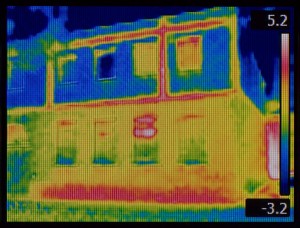Infrared inspections call tell you about many hidden defects

Missing Insulation
One of the most common uses for an infrared camera is to check behind walls and ceilings to see if any areas may be missing or low on insulation. An infrared inspection is also helpful even for areas where you can clearly see the insulation, such as an unfinished attic. After all, sometimes insulation looks perfectly normal but is actually compromised in some way and allows heated or cooled air to escape.
Air Leaks
If you suspect your home is losing air around windows and doors or through other leaks in the building envelope, you could use an infrared camera to confirm your suspicions. If you want to know just how much air is being lost, ask Econo West Heating Air & Plumbing about our air balancing service which includes measuring the airflow in your home.
Water Leaks
Infrared cameras are often used for leak detection. The most common scenario is for rain water leaking through the roof or groundwater seeping into the basement to show up as dark spots on the infrared camera. Checking for slab leaks is also possible. The camera can also be very useful if you need to check for slow leaks from a shower with a tiled floor. Simply plug the shower drain and fill the bottom of the shower with an inch or two of hot water. The infrared camera will show you if any water is leaking into the ceiling on the floor below the shower.
Electrical Problems
When electrical conduits or circuit breakers are overburdened or incorrectly configured, they can get hot. Taking a peek with an infrared camera can help reveal electrical problems and give you a heads up that you need to call an electrician.
Hidden Floor Registers
Occasionally, contractors make odd mistakes. One example is a carpet installer laying down wall-to-wall carpet right over the floor registers. If you didn’t own the home when the carpet was installed, you might never realize it. Unless that is, you had an infrared camera inspection while the heat was turned on.
Damaged In-Floor Heating
Having radiant heating on your floors can feel pretty luxurious, but with the pipes for delivering the heat hidden beneath your flooring, it can be difficult to be sure everything is working properly. By turning on the heat and then viewing the floor with an infrared camera, it’s easy to see exactly where the heat is being transmitted and confirm the presence of any damaged areas.






